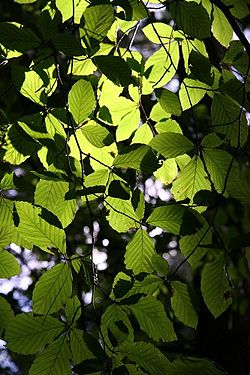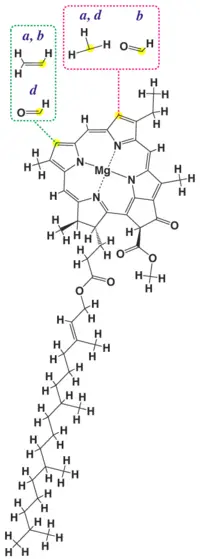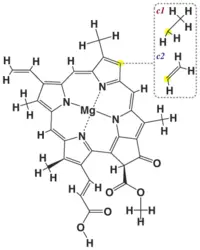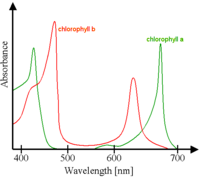Chlorophyll
Chlorophyll is a green photosynthetic pigment found in plants, algae, and cyanobacteria. Its name is derived from ancient Greek: chloros = green and phyllon = leaf. Chlorophyll absorbs mostly in the blue and to a lesser extent red portions of the electromagnetic spectrum, hence its intense green color.
Chlorophyll and photosynthesis
In plant photosynthesis, incoming light is absorbed by chlorophyll and other accessory pigments in the antenna complexes of photosystem I and photosystem II. The antenna pigments are predominantly chlorophyll a, chlorophyll b and carotenoids. Their absorption spectra are non-overlapping, which serves to broaden the specific bandwidths of light these individual compounds absorb during the process of photosynthesis. The carotenoids also play a role as antioxidants, and serve to reduce photo-oxidative damage to chlorophyll molecules.
Each antenna complex has between 250 and 400 pigment molecules, and the energy they absorb is shuttled by resonance energy transfer to a specialized chlorophyll a at the reaction center of each photosystem. When either of the two chorophyll a molecules at the reaction center absorb energy, an electron is excited and transferred to an electron-acceptor molecule, leaving an electron hole in the donor chlorophyll. In a poorly-understood reaction, electrons from water molecules participate in an oxidation reaction, where the hole from the donor chlorophyll is filled (recombined with another electron), and diatomic oxygen is produced. Resulting chemical energy originating from the initial excited electron is eventually captured in the form of ATP and NADPH, and is then ultimately used to convert carbon dioxide (CO2) to carbohydrates. This CO2 fixation process results in the conversion (or an integrated external quantum efficiency) of 3% to 6% of the total incident solar radiation, with a theoretical maximum efficiency of 11%. [1]
Special pair
The photosystem reaction centers consist of a "special pair" of chlorophyll a molecules that are characterised by their specific absorption maximum. The special pair in photosystem I are designated P700, and those from photosystem II are designated P680. The P is short for pigment, and the number is the specific absorption peak in nanometers for the chlorophyll molecules in each reaction center.
Chlorophyll a is common to all eukaryotic photosynthetic organisms, and, due to its central role in the reaction center, is essential for photosynthesis. The accessory pigments such as chlorophyll b and carotenoids are not essential. Some algae, such as brown algae and diatoms, use chlorophyll c as a substitute for chlorophyll b. Historically, red algae have been assumed to have chlorophyll d, although it could not be isolated from all species and even different collections of the same species. This puzzle has recently been resolved, since the chlorophyll d is actually from an epiphytic cyanobacterium (Acaryochloris marina) that lives on the red algae. These cyanobacteria have a ratio of chlorophyll d: chlorophyll a of approximately 30:1, and represent a rare example of a photosystem with chlorophyll d at the reaction center of the photosystem. All other known eukaryotes and cyanobacteria use chlorophyll a. There are likely to be many chlorophyll-d containing organisms awaiting discovery, for example a free living form was recently found in the Salton Sea (a salt lake in USA).
Other chemical variations of chlorophyll are found in photosynthetic bacteria, other than cyanobacteria. Purple bacteria use bacteriochlorophyll, which absorbs infrared light between 800nm - 1000nm, and the green sulphur bacteria chlorobium chlorophyll. All known bacteria with bacteriochlorophyll have a form of photosynthesis which does not involve evolution of oxygen and so are called anoxyphotobacteria. There is a very large number of different bacteriochlorophylls in different anoxyphotobacteria including one species which contains Zinc, rather than the usual Magnesium as the co-ordinated metal.
Chemical structure
|- | C3 group | -CH=CH2 | -CH=CH2 | -CH=CH2 | -CH=CH2 | -CHO |- | C7 group | -CH3 | -CHO | -CH3 | -CH3 | -CH3 |- | C8 group | -CH2CH3 | -CH2CH3 | -CH2CH3 | -CH=CH2 | -CH2CH3 |- | C17 group | -CH2CH2COO-Phytyl | -CH2CH2COO-Phytyl | -CH=CHCOOH | -CH=CHCOOH | -CH2CH2COO-Phytyl |- | C17-C18 bond | Single | Single | Double | Double | Single |- | Occurrence | Universal | Mostly in land plants | Various algae | Various algae | cyanobacteria |}
Evidence for chlorophyll
Chlorophyll can be shown to be vital for photosynthesis by destarching a leaf from a variegated plant and exposing it to light for several hours. (Variegated leaves have green areas that contain chlorophyll and white areas that have none.) When tested with iodine solution, a color change revealing the presence of starch occurs only in regions of the leaf that were green and therefore contained chlorophyll. This shows that photosynthesis does not occur in areas where chlorophyll is absent, and constitutes evidence that the presence of chlorophyll is a requirement for photosynthesis.
(Whoever put this spectrum in got it wrong. The absorption peak for Chl b is at 647 nm. The spectrum shown as the red line is for Chl c1 or Chl c2 which peak at 630 nm. The Chl a spectrum is correct. Please relabel it. Dr Ray Ritchie - Uni of Sydney)
ReferencesISBN links support NWE through referral fees
- Speer, Brian R. (1997). "Photosynthetic Pigments" in UCMP Glossary (online). University of California, Berkeley Museum of Paleontology. Verified availability March 20, 2006.
- PDF review-Chlorophyll d: the puzzle resolved
Credits
New World Encyclopedia writers and editors rewrote and completed the Wikipedia article in accordance with New World Encyclopedia standards. This article abides by terms of the Creative Commons CC-by-sa 3.0 License (CC-by-sa), which may be used and disseminated with proper attribution. Credit is due under the terms of this license that can reference both the New World Encyclopedia contributors and the selfless volunteer contributors of the Wikimedia Foundation. To cite this article click here for a list of acceptable citing formats.The history of earlier contributions by wikipedians is accessible to researchers here:
The history of this article since it was imported to New World Encyclopedia:
Note: Some restrictions may apply to use of individual images which are separately licensed.



